Enquire Now
Fill out the form below and we will get back to you as soon as we can.

Sharing is caring!
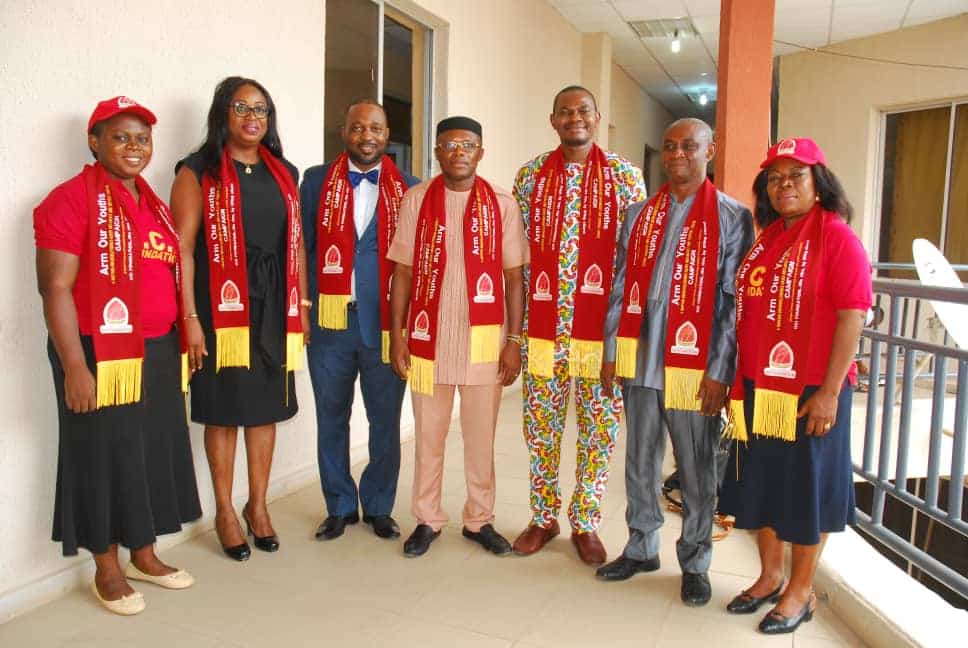
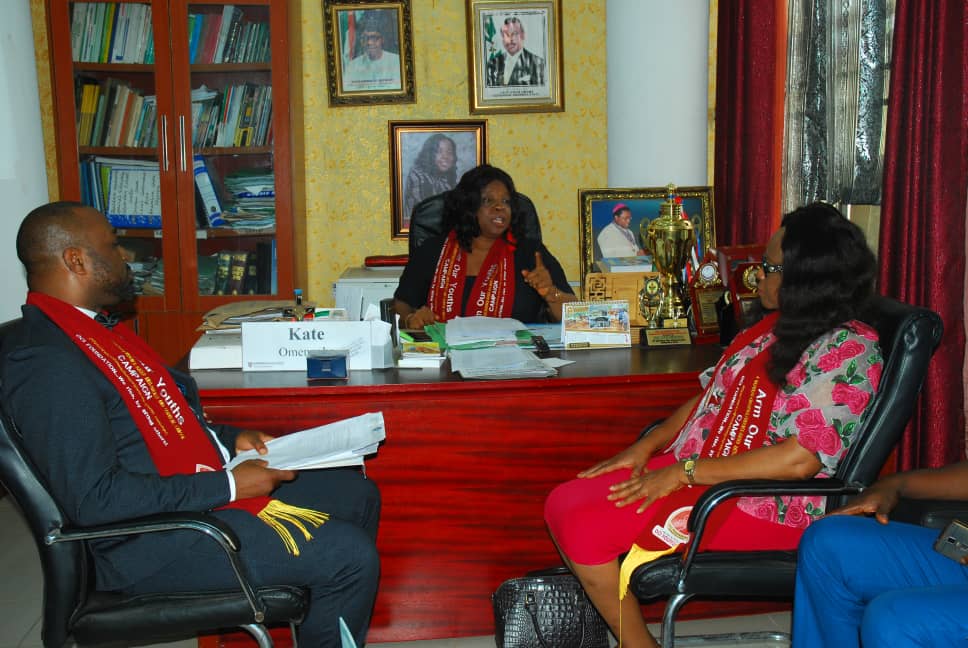
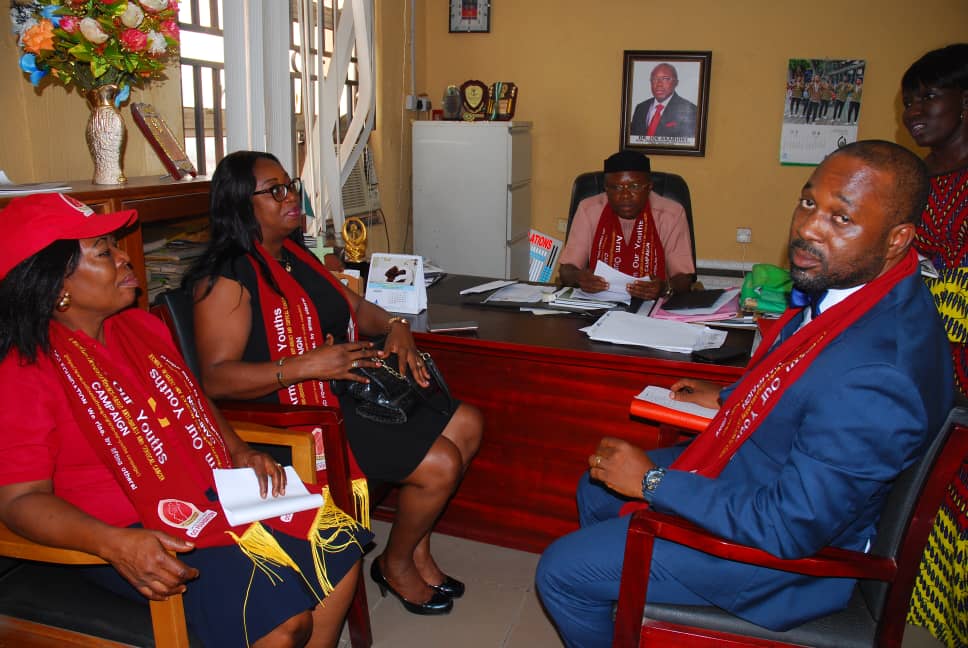

The Arm Our Youths Health Campaign, otherwise known as the “ArOY Campaign”, is a health promotion initiative of the OCI Foundation. It started 2019, following the Foundation’s two years of annual heath symposium on breast and cervical cancer preventive techniques.
At the OCI Foundation, we believe that, for breast and cervical cancer awareness campaigns in Nigeria and other low to lower-middle income countries to be sustainable, affordable and all-encompassing, they need to target young, mostly-teenage adults in high schools. Inclusion into the regular academic curriculum of the schools, along with repeated teachings and in-built assessment systems across each of the final three years of Nigerian senior secondary (high) schools, are the cornerstones of the ArOY campaign.
The idea, plans and approaches of this campaign are primarily the brain-child of the OCI Foundation, and have been developed through some input from the Harvard Medical School, Boston, the United States of America.
Components of the Campaign:
The need for the ArOY Health Campaign is urgent, and needs to reach a lot of women as soon as possible. As such, the program is premised on a slogan that reflects all these. We therefore aim to Arm Our Youths by . . . Arming them Young, Arming them Now, and Arming them All. The ArOY Anthem (video and lyrics), an inspiring piece worth listening to, captures this concept nicely.
The main targets are all the young adults in Nigerian Senior Secondary Schools. However, the Campaign is open to all other adults in Nigeria, and this is achievable through the Foundation’s CerviBreast mobile phone application, which is freely available to everyone on the Smart Phone App stores.
The OCI Foundation has established enduring partnerships to ensure that as many young Nigerians as possible can benefit from this Campaign (see list of partners below). Young Nigerian undergraduates in tertiary institutions, fresh graduates undergoing the National Youth Service Corps (NYSC) program, and a few other groups are all being targeted by the ArOY Campaign. For each group, measures are in place to ensure “engagement” to the teachings of the Campaign, as this is the unique feature that marks the ArOY Campaign out from other cancer awareness exercises.
Specific Aims
The ArOY Campaign was designed to introduce breast and cervical cancer preventive campaigns into the academic curricula of all high schools across Nigeria. This will be in phases, with Anambra State, our primary locality, being the first state to benefit. This was successfully flagged off after a 3-day ceremony from September the 10th to the 12th, 2019, following a colorful, star-studded event at the main auditorium of the Nnamdi Azikiwe University, Awka, Nigeria. The activities over the 3 days are available through the Program Brochure Booklet INSIDE.
All the pictures from the Flag-off Ceremony (Day 1) are available HERE, while those from the Workshops (Days 2 and 3) for teachers in all 261 senior secondary schools in Anambra State can be seen HERE. To watch the full documentary of the activities over the 3 days, click HERE.
Teachings across all 261 eligible schools in Anambra State commenced in the week of September 15th, 2019, and will be ongoing into the foreseeable future, in a self-sustaining manner. As is the case with all of the OCI Foundation’s projects, the ArOY Campaign has a research component. This research adopts a Cluster Randomized Controlled Trial technique to evaluate the program, and ensure that areas of improvement on the initiative are identified and implemented accordingly. Details of this research, which is being overssen by the Griffith University School of Medicine, Australia, are available HERE.
Following this successful introduction in Anambra State, the ArOY Campaign is to be extended to the rest of the senior secondary schools (SSS) in all other Nigerian states and geopolitical zones. The roll-out across the Nigerian nation is expected to be complete on or before the Year 2025. Deliberations for this roll-out is already ongoing, with high-level meetings consultations taking place between the OCI Foundation and major stakeholders. Pictures of some of these are available HERE, HERE and HERE.
For the primary targets, there are 3 main aims:
Firstly, it is to increase the proportion of all (male and female) senior secondary (high) school students with correct knowledge of the Early Symptoms, Risk Factors and Preventive Practices of the two cancers.
Secondly, we aim to increase the proportion of female students that practice monthly breast self-examination (BSE). To this end, the CerviBreast App was successfully into the Android Google App Store in September 2019. This is freely available, and is designed to stimulate compliance to this life-saving practice by sending monthly reminders.
Finally, we hope to ensure that the knowledge gained from our interventions are sustained, and we hope to achieve through this through sustained and prolonged engagement to the necessary teachings in the decades to come. We ensure “engagement” by ensuring that the teachings are repeated for each student cohort as they go through SSS classes 1, 2 and 3, and, at each level, in-built assessment systems incorporated to the Campaign means that there are examinations and quizzes. Each school gets multiple copies of free OCI ArOY Textbooks which are donated at no cost to the schools by the OCI Foundation, and deposited permanently in their respective libraries. This complements the teachings, and help ensure engagement.
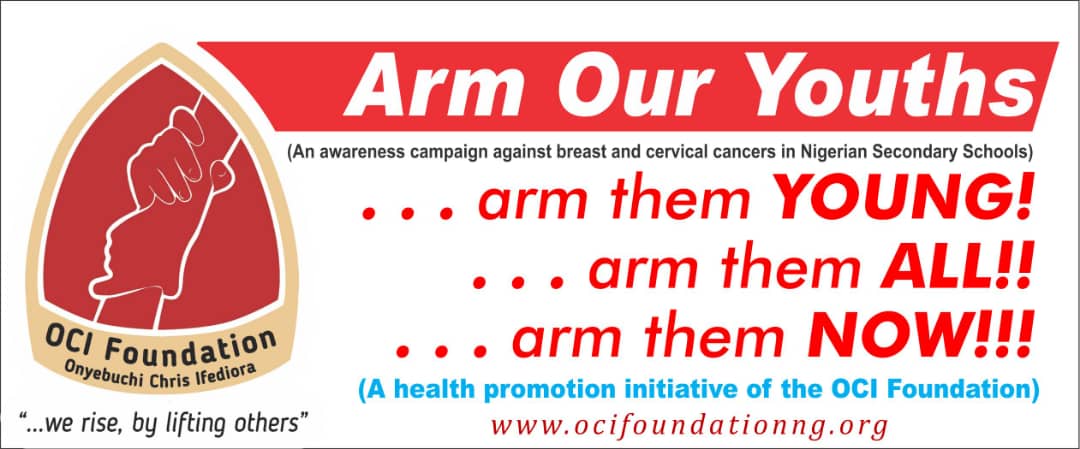
Background
Since 2017, the OCI Foundation has been at the vanguard of youth empowerment on preventive measures against breast and cervical cancers for female senior secondary school students in Otuocha Educational Zone of Anambra State, South-eastern Nigeria. This program has been a resounding success, with excellent feedbacks from guests and participants alike.
However, due to the limitations enforced by limited space and finances, we can only reach out to a few hundreds of participants at any point in time. And we have no way of sustaining the lessons imparted on these participants one they graduate from high school.
The ArOY Campaign was developed from these experiences of the OCI Foundation, and is designed to have a permanent solution to them.
Campaign Rationale
Statistics linked to breast and cervical cancers highlight the burning platform they pose in Nigeria and other developing countries, as well as the urgent need for preventive actions. In 2012, for instance, these countries accounted for 445,000 (84%) of all cervical cancer occurrences, along with 270,000 (85%) of the resultant deaths.1 In Nigeria, about 50.3 million women aged 15 years or more are at risk of cervical cancer, and about 8,240 of the 14,089 that had the disease in 2017, died.2 Projections have it that, by the year 2025, cervical cancer deaths may rise by 63% among affected women aged “≤ 65”, and 50% for those “> 65” years.3
Breast cancer, on the other hand, was responsible for 571,000 global deaths in 2015,4 and its incidence has risen steadily from 1-in-20 women in 1960, to the current 1-in-8.5 Incidences in developing countries are historically lower than that seen in developed countries, but the gap is closing considerably. Unfortunately, outcomes from these developing countries remain poor, with five-year survival rates of about 10%, compared to 70% in developed countries.6
Poor knowledge of preventive strategies,6,7 along with the almost non-existent government-sponsored vaccination and screening programs in Nigeria and other developing countries,1 contribute to these poor statistics. Despite the apparent show of concern from the concerned governments, limitations in funds mean that this unfortunate trend will most likely continue. The implication, therefore, is that direct empowerment of women, through health campaigns, present the most realistic and affordable intervention measures in these countries.
Such campaigns are known to improve knowledge, preventive practices, screening uptake, and the adoption of positive behaviours.8 Combined, these will ultimately reduce the cancers’ incidences.3 For the foreseeable future in Nigeria, these campaigns actually remain the only realistic options available to millions of women, and underlines the need to take seriously the innovative, high-impact, and low-cost approach proposed in this project.
The measures adopted in the ArOY Campaign were primarily by the observations of the OCI Foundation, through evaluations of her anti-cancer campaigns since 2017. Peer-reviewed articles, published by a team lead by the Foundation’s President in journals of international reputation, would reveal the basis for these programs. 9-12 Direct access to the concerned publications can be found HERE, HERE, HERE, and HERE.
However, a full journal article discussing all of these is available here: https://bmcpublichealth.biomedcentral.com/articles/10.1186/s12889-019-6890-2.
About 72.8% of Nigerians aged 15 to 24 years are literate, so any school-based program will reach a majority of young adults in the country. The ensuing paragraphs provide the rationale for intervening at young ages.
One reason for advocating interventions in senior secondary schools, which is applicable to both cervical and breast cancers, is that most teenage participants will, at some point in their lives, attend higher institutions, become mothers, get employed, and get involved in wider community activities. They, therefore, have many years and opportunities to pass on the
knowledge to others, including their children, grandchildren, friends, school mates, work colleagues, and others in the society. The impact of empowering them early will, therefore, be multiplicative, and have a long term spill-over effect in the societies concerned.
Other justifications are unique to the respective cancers, and are now highlighted for each cancer.
Cervical Cancers: Firstly, most cervical cancer cases in developing countries present among women in their mid-30s, an age which is up to 15 years earlier than occurrences among women in developed countries. Given that most infections with the cervical cancer-causing Human Papilloma Virus (HPV) take 10 to 20 years before progressing to full-blown cancers, a reasonable assumption is that the earliest exposures to clinically significant HPV infections would be in the mid-teens, and before or shortly after the age of 20 years. This is consistent with the report that the age of first sexual exposure for women in Nigeria is 16.7 to 17.9 years, which, incidentally, is the age at which most females are in the final year of their senior secondary schools. It has also been reported that up to 12% of cervical cancer cases in developing countries like Nigeria occur in women under the age of 30 years.
Another reason for advocating anti-cervical cancer interventions in senior secondary schools is based on the fact that the proportion of sexually active females in Nigerian tertiary institutions (like universities) range from 71.2%11 to 81.5%. This means that, for a good proportion of women in Nigerian tertiary institutions (usually in their late teens to mid- twenties), potential exposures to HPV would have already occurred. Notably, only 15.6% of 16-year-old Nigerian women (likely to be in senior secondary schools) are sexually active, while as many as 51.7% were already sexually active before the age of 20 years. Therefore, interventions before progression to tertiary institutions, and before the age of 20 years, is justifiable, and this is the approach being advocated by the ArOY Campaign.
Even though it has been established that women who have heard about cervical cancers are statistically more likely to be aware of its risk factors and early warning symptoms, most young Nigerian women remain unaware of the associations between sexual exposure and cervical cancer.
Breast Cancers: Regarding breast cancers, it is known that the cumulative frequencies of occurrences were 0.8% at age ≤20 years and 3.3% at <25 years. In fact, a case has been reported in a patient as young as 14 years. Despite this small but significant risk faced by young adults, a 2017 study of teenage females in Nigerian high schools observed a poor level of knowledge on breast cancer risk factors and its early warning symptoms. In addition, only 6.1% practiced monthly breast self-examinations (BSE), with very few knowing the correct techniques and timing.
Given that breast cancer prognosis in younger patients is poor, early screening and detection among the younger age group are vital in a developing country like Nigeria, where no other functional preventive programs are in place.16 Such early detection is linked to a reduction in associated morbidities and mortality.
Summary of the justifications: In view of the foregoing discussions, it becomes obvious that the duo of cervical and breast cancers have their roots in early adulthood, and delaying enlightenment interventions to mid or late adulthood would come late to many, as exposure to irreversible risks might have occurred. This problem is of a huge significance in most developing countries like Nigeria, which have little to no organized, all-encompassing, government-sponsored preventive programs. Even though targeted at young men and women, the ArOY Campaign will benefit women of all ages, professions, and ethnic, religious or social orientations. It will also benefit every man with a woman in his life, which in reality, means everyone, since there must be a mother, sister, wife, daughter, grand-daughter, friend, and female associates in every man’s life.
In addition to the teachings and assessments in senior secondary schools, the ArOY Campaign integrates technology into its activities. To this end, a mobile phone application, called the OCI CerviBreast App, is freely available on the Android/Google and Apple/iPhone/IOS App stores. Unlike other similar applications before it, this App is unique in that it can be configured to suit every single woman with respect to her monthly cycle, in such a way that a series of reminders will be received at the right time for the practice of breast self-examinations (BSEs).
The ArOY Campaign also has a video demonstration of the BSE, which is freely available online and on the CerviBreast App. The App also contains lots of other anti-breast and anti-cervical cancer messages, and a link for direct communication with experts in the OCI Foundation. This CerviBreast App is, therefore, a must for everyone to have, be it male or female, young or old. And it is free! Go to the Android Google Play or iPhone’s App Store to download it now!!!
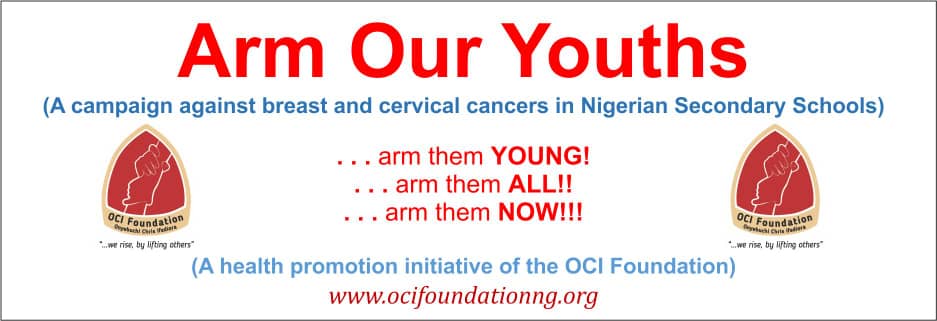
PARTNERS AND COLLABORATORS
We are mindful of the fact that changes like those being proposed in the ArOY Campaign are not easy to push through. We anticipate that there may be difficulties to surmount, if we are to translate our dreams and vision, to effective realities. As such, the ArOU Campaign adopts a strategy where stakeholders are set up as committees before its implementaion in each State or Region. For Anambra State, a 28-man Implementation/Steering Committee, made up of seasoned and experienced stakeholders and technocrats, worked to ensure that the implemented curriculum, along with its implementation, was not only all-encompassing, but also culturally, socially and religiously acceptable to all. The members of the Anambra State Implementation Committee can be seen HERE.
In view of the foregoing, the OCI Foundation collaborates with has established (or seek to establish) partnerships. Video confirmation of these partnerships are available HERE. A list of the the Foundation’s collaborations include:
In the coming months and years, the ArOY, we believe, will dominate discussions and policy meetings in the public and private engagements within and outside Nigeria. We are excited about this opportunity to save lives in ways that are not only sustainable and cost-effective, but also wide-reaching and effective. The excitement is growing, and a number of leading Nigerian news outlets have already reported this project. Anyone with interest can gain further insights by reading these reports from various news media outlets, most of which are available HERE.
The ArOY Campaign is an expensive campaign, aiming to reach millions on women over the next few years. The costs run into hundreds of thousands of United States Dollars (millions of Nigerian Naira). Non-financial donations can be in the form of cars, office spaces, sponsorship for educational materials, and so on. Follow the link below to donate, or contact us to discuss sponsorships.
No donation is small. Please remember that all donations to the OCI Foundation is tax deductible, particularly in Australia. Donations through PayPal or Bank Cards can be made HERE.
. . . Join us, as we ARM OUR YOUTHS!
. . . Join us, as we ARM THEM YOUNG!!
. . . Join us, as we ARM THEM ALL!!!
. . . Join us, as we ARM THEM NOW!!!!
Join us, as we rise, by lifting others!!!!!
Fill out the form below and we will get back to you as soon as we can.